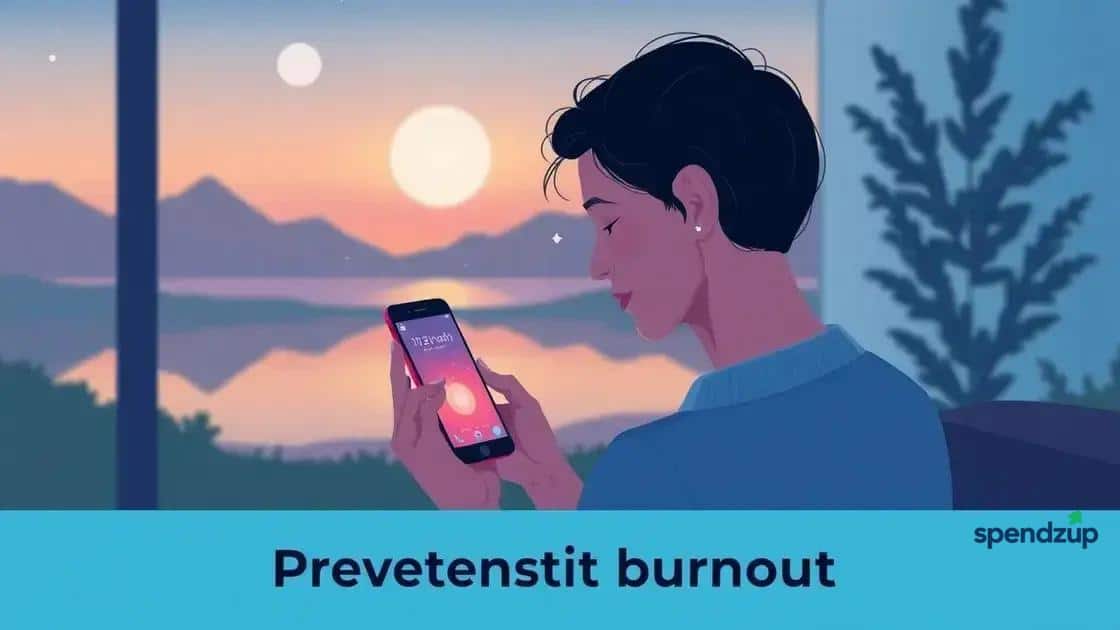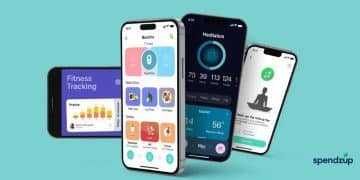Digital burnout awareness: how to combat it effectively

Digital burnout awareness is crucial for recognizing signs of stress and implementing strategies like setting boundaries, taking breaks, and engaging in offline activities to promote mental well-being.
Digital burnout awareness has become more important than ever in our tech-driven lives. Have you felt overwhelmed by constant notifications or endless screen time? In this article, we’ll explore ways to recognize and manage this modern fatigue.
Understanding digital burnout
Understanding digital burnout is essential in today’s technology-driven world. Many individuals experience feelings of exhaustion and overwhelm from constant device usage. This phenomenon can impact both mental well-being and productivity tremendously.
What is digital burnout?
Digital burnout occurs when individuals feel drained and fatigued due to excessive digital engagement. This can manifest in various ways, including irritability, anxiety, and decreased motivation. It’s important to recognize that the virtual world can sometimes feel relentless, leading to significant stress.
Signs of digital burnout
Identifying the signs of digital burnout is crucial for intervention. Some common symptoms include:
- Persistent feelings of tiredness
- Lack of interest in previously enjoyable activities
- Difficulty concentrating on tasks
- Increased irritability or frustration
When these symptoms arise, it may be time to assess your relationship with technology. Understanding these signs can help you take proactive steps toward managing your online presence and improving your mental health.
Practice self-awareness about how long you spend online and the impact it has on your daily life. You may find that recognizing your patterns helps in making necessary adjustments. By focusing on balance and moderation, you can mitigate the negative effects of digital overload.
Consequences of ignoring digital burnout
Ignoring symptoms of digital burnout can lead to several negative outcomes, including:
- Decreased productivity at work or school
- Problems in personal relationships
- Physical health issues such as headaches or sleep disturbances
Addressing digital burnout promptly not only aids in personal well-being but also enhances overall quality of life. Finding ways to unplug and recharge is integral for maintaining mental health.
Signs and symptoms to watch for

Recognizing the signs and symptoms of digital burnout is vital for timely action. Many people may not realize they are experiencing burnout until it becomes overwhelming. It’s helpful to know what to look for so you can address it early.
Common signs of digital burnout
Some of the most common signs include:
- Feelings of constant fatigue
- Increased irritability or mood swings
- Difficulty concentrating on tasks
- Loss of interest in activities once enjoyed
If you notice these signs, it’s important to take a step back and evaluate your digital habits. Awareness can lead to meaningful changes.
Physical symptoms
The impact of digital burnout isn’t only emotional; it can also have physical effects. Pay attention to your body for signs such as:
- Headaches or migraines
- Aches and pains in the neck or back
- Eyestrain or blurry vision
These physical symptoms can be a wake-up call that your relationship with digital technology needs adjusting. It’s essential to listen to your body.
Another indication of digital burnout is trouble sleeping. If you find it difficult to fall asleep or stay asleep, your excessive screen time might be disrupting your natural sleep cycle. Evaluate your technology use, particularly in the hours leading up to bedtime.
Experiencing a lack of enthusiasm for work or personal projects is also a key signal. If your usual drive and motivation seem absent, it’s time to reassess your engagement with digital media. Make sure you’re giving yourself time to recharge.
Effective strategies to reduce burnout
Effective strategies to reduce burnout are essential for anyone feeling overwhelmed by digital demands. Implementing changes in daily routines can help restore balance and boost mental health. Here are some actionable solutions to consider.
Set clear boundaries
Establishing boundaries with technology is crucial. Consider the following:
- Limit screen time to specific hours each day.
- Avoid checking emails or messages after a certain time.
- Designate tech-free zones in your home.
By setting clear limits, you can create a healthier relationship with your devices.
Take regular breaks
It’s important to step away from screens periodically. Structured breaks can improve productivity and increase focus. Try these tips:
- Use the 20-20-20 rule: every 20 minutes, look at something 20 feet away for 20 seconds.
- Engage in physical movement every hour.
- Practice mindfulness or deep breathing exercises during breaks.
Implementing regular breaks can rejuvenate your mind and body, reducing feelings of burnout.
Engaging in hobbies away from screens is another effective strategy. Whether it’s reading a book, cooking, or going for a walk, hobbies can provide a mental escape. Finding joy in offline activities can help you recharge and foster creativity.
Additionally, prioritizing sleep is crucial for battling burnout. Ensure you have a consistent sleep schedule by going to bed and waking up at the same time daily. A good night’s sleep restores energy levels and enhances mental clarity.
Seek support from others
Don’t hesitate to talk to family and friends about your feelings of burnout. Sharing your experiences can lighten the emotional load. Join support groups or online communities that focus on mental health. Connecting with others can provide valuable insights and encouragement.
The role of technology in preventing burnout

The role of technology in preventing burnout is often overlooked. While technology can contribute to stress, it also has the potential to offer solutions that promote well-being and balance. Understanding the positive aspects of technology can help individuals manage their mental health effectively.
Using apps for mindfulness
Various apps are designed specifically to help users practice mindfulness and relaxation. These apps provide tools for meditation, breathing exercises, and stress management. Some popular options include:
- Headspace: Offers guided meditations for beginners and experienced users.
- Calm: Features sleep stories and relaxation techniques.
- Insight Timer: A community of meditation lovers sharing resources.
These tools can greatly aid in reducing anxiety and promoting relaxation.
Managing screen time
Technology can also help you monitor and manage your screen time. Many smartphones come with built-in features that track usage and set limits. This can help you recognize patterns and make necessary adjustments to your daily routine. Tools for tracking include:
- Usage tracking apps that show time spent on devices.
- Notification settings to minimize distractions.
- Focus modes that limit access to certain apps.
By using these features, you can establish healthier boundaries with technology.
Social media platforms can also play a role in preventing burnout. Connecting with supportive communities online can provide encouragement and resources. Follow accounts that promote positivity and mental health awareness. Engaging with uplifting content can serve as a strong support system and help combat feelings of isolation.
Moreover, technology enables remote work options that can enhance work-life balance. Many companies now offer flexible hours and remote work arrangements. This flexibility can reduce commute stress and allow for a more fulfilling personal life. Embracing such options can make a significant difference in managing burnout.
Creating a balanced digital lifestyle
Creating a balanced digital lifestyle is crucial for maintaining mental health and preventing burnout. It involves finding harmony between online engagement and offline activities that recharge and fulfill you. By intentionally managing your time and habits, you can cultivate a healthier relationship with technology.
Assess your technology use
The first step in creating balance is to evaluate how much time you spend on digital devices. Consider tracking your screen time to understand your habits. Once you see the data, reflect on:
- The hours spent on social media
- Time spent on work-related tasks
- Entertainment choices and their impact on your mood
This assessment can help identify areas where you might need to cut back or change your approach.
Establish daily routines
Routines play a vital role in balancing digital and real life. Consider setting specific times for checking emails and social media. Designating periods for focused work, leisure, and rest strengthens your daily structure. To enhance your routine:
- Schedule tech-free meals with family or friends.
- Dedicate weekends to outdoor activities.
- Incorporate regular exercise that keeps you away from screens.
By prioritizing these practices, you can make meaningful connections outside the digital realm.
Additionally, try implementing a digital detox periodically. This means taking specific breaks, like a weekend or week-long hiatus from all forms of technology. This can significantly recharge your mind and help foster creativity.
Make sure to fill your offline time with activities you enjoy. Hobbies, such as gardening, painting, or reading, can provide enrichment and help you unwind. Engage in social activities that encourage face-to-face interactions, making an effort to cultivate connections in the real world.
In conclusion: Embracing a balanced approach to digital life
Maintaining a healthy relationship with technology is essential in today’s fast-paced world. By understanding the signs of digital burnout and implementing effective strategies, you can improve your mental health and overall well-being.
Creating a balanced digital lifestyle requires conscious choices about your technology use. Setting boundaries, taking breaks, and engaging in offline activities are key steps toward achieving this goal.
Remember, it’s not just about reducing screen time but also about enriching your life with meaningful experiences outside the digital realm. Embrace these changes, and you’ll find yourself more energized and connected in both your online and offline worlds.
FAQ – Frequently Asked Questions about Digital Burnout Awareness
What are the signs of digital burnout?
Common signs include constant fatigue, irritability, difficulty concentrating, and loss of interest in activities you once enjoyed.
How can technology help prevent burnout?
Technology can provide mindfulness apps, track screen time, and facilitate remote work options that help maintain a balanced lifestyle.
What strategies can I use to create a balanced digital lifestyle?
Setting clear boundaries with technology, taking regular breaks, and engaging in offline activities are effective strategies to achieve balance.
Why is it important to engage in offline activities?
Engaging in offline activities helps recharge your mind, fosters social connections, and reduces dependency on technology, promoting overall well-being.





